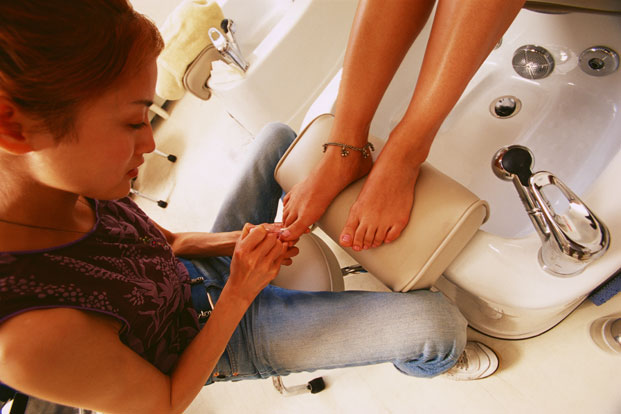After a long winter, being able to shed our winter boots for cute sandals means finding a way to make our winter-worn hooves look beach beautiful. Combined with the need for a relaxing afternoon of pampering, this makes a pedicure sound like a must for our to-do list. What most of us don’t realize is that a pedicure isn’t just applying some nail polish and massaging our calves — it’s a formal procedure. Nail technicians are required to complete training, and nail salons must go through licensing processes to minimize the risk of infections in their clientele. Unfortunately, this isn’t always the case.
Your salon probably uses Barbicide, UV light “sterilizer” boxes and chemical solutions to disinfect tools. While this means that they are complying with regulations for their industry, it doesn’t mean that these steps are effective at killing all bacteria and infectious agents from the tools that will come in contact with our skin. Only facilities that sterilize their equipment in an autoclave — a machine that uses pressure and steam — can say that their tools are truly sterilized. However, tools such as nail files are rarely sterilized, and tools such as emery boards, pumice stones, nail buffers and foam toe separators cannot be sterilized, leaving open a risk for transferring fungal infections during the pedicure or manicure.
Foot baths may add to the luxury of our pedicures, but they can harbor infectious agents as well. The Centers for Disease Control and Prevention (CDC) track clusters of infectious outbreaks and documented a cluster outbreak of Mycobacterium fortuitum, a cutaneous infection that spread to more than 100 spa customers from foot baths in a Northern California nail salon. These patients wound up with prolonged boils on their lower legs that left scars when the boils healed.
If this isn’t enough to get you soaking and polishing your feet at home, here are five pedicure procedures that you should modify or wipe out of your pedi routine to minimize your risks of infections:
Whirlpool Foot Spas – Skip the Jets
If your salon doesn’t have simple tub foot soaks and you’re opposed to seeking out one that does, ask that your pedicurist not turn on the whirlpool during your foot soak. The jets in the whirlpool are harder to clean than the basin and can harbor bacteria and fungus. Ask your salon if they run the required minimum 10-minute sanitation cycle between clients on their foot baths or refuse to sit in a chair you know was just occupied by a previous client and not properly cleaned. If you want to be even more safe, you can also look into buying and bringing your own foot bath liners to avoid cross-contamination with previous clients.
Just Say No to Sharing
When you walk into the salon for your appointment, you should look for a business that has their tools soaking in a blue liquid disinfectant (like Barbicide) and make sure that all the soaking tools look like they were properly cleaned prior to being put in the jar. You want to avoid salons that are using UV lights to sanitize tools because it takes much more than that to kill the bacteria and fungus that could be hanging out on them. Further, any non-metal tools, including nail files, foot pumices and buffers, should not be shared between clients because they cannot be sterilized. Want to be sure that your tools are all your own? You can create a BYO mani/pedi kit by visiting any beauty supply store and bringing your own tools with you to each visit. Be sure that you sterilize them afterward, in case they came into contact with other used or non-sterilized tools at the salon.
Be Careful with Cutting
You need to instruct your pedicurist to cut toenails straight across the contour of the nail and never into the corners, which will encourage the nail to grow into the skin, causing painful ingrown toenails. Rounded fingernails are one thing — rounded toenails are a no-no. If possible, ask your nail technician to avoid cutting your cuticles altogether and ask that they simply push them back to avoid bacterial infections.
Stay Hairy or Skip the Leg Massage
Those leg massages that come with pedicures have many women grabbing the razor before heading out the door so that our legs don’t feel like pine trees, but it can increase the risk of infection. Small cuts can allow bacteria to be introduced into breaks in the skin, causing cellulitis or MRSA infections. Doctors recommend waiting at least two days after shaving before going in for a pedicure or you can ask your pedicurist to skip the leg massage altogether.
Avoid Door Buster Deals
Group coupon sites and promotional discounts for mani-pedi specials are incredibly tempting for those of us who want to work some luxury into our monthly budgets. These deals, however, can lead to crowded salons and quick turnover, which can mean that sanitation procedures are subject to cut corners or missed steps to accommodate the salon’s bottom line. To minimize your risks, you should try to schedule a pedicure on a weekday morning when possible, when food baths have been freshly sanitized and have not been used by multiple clients already.
Following the above-outlined steps can minimize your risk of contracting an infection during your next pedicure. Most of all, use common sense. If the salon you walk into doesn’t look like it’s up to code or if you’re asked to sit at a station where you know a foot bath hasn’t been properly disinfected, speak up and say no.
If you have a procedure done and notice that you have redness around any cuts in your skin, especially redness that’s accompanied by streaking that radiates out from the wound, visit your doctor immediately to deal with what might be cellulitis or another infection. Early treatment is key to a quick recovery with antibiotics and will prevent the infection from spreading or becoming serious.

Leave a Reply